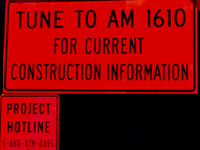Project-Level Public Information and Outreach Examples


At the project-level, work zone public information and outreach strategies are used to communicate with road users, the general public, area residences and businesses, and appropriate public entities about project information; road conditions in the work zone area; and the safety and mobility effects of the work zone. According to some States, public information is one of the most cost-effective work zone impact mitigation strategies, in both urban and rural areas.
Effective use of public information and outreach strategies can lead to improved driver and worker safety, less traffic delay, and reduced driver frustration. The Work Zone Safety and Mobility Rule requires that public information and outreach strategies be included in Transportation Management Plans (TMPs) for significant projects.

